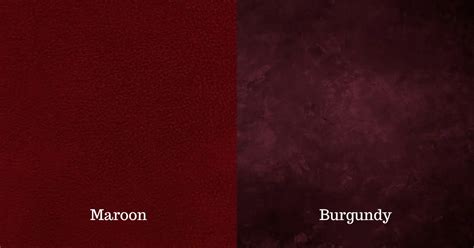Introduction
Maroon and burgundy, two alluring shades of red, often raise questions about their perceived distinctions. While they may appear similar to the untrained eye, these hues possess subtle yet profound differences that set them apart in the world of color. This comprehensive article will delve into the nuances of maroon vs burgundy, exploring their unique characteristics, applications, and cultural significance.

Defining Maroon and Burgundy
Maroon
Maroon, a deep shade of reddish-brown, is derived from the French word “marron,” meaning chestnut. It is characterized by its warm, earthy tones, reminiscent of the glossy hue of ripened chestnuts.
Burgundy
Burgundy, on the other hand, is a rich, purplish-red color. Its name originates from the Burgundy region of France, renowned for its fine wines. Burgundy possesses a more sophisticated and regal aura, with hints of deep red and violet.
Distinguishing Features
Hue and Saturation
The primary difference between maroon and burgundy lies in their hue and saturation. Maroon leans towards the brownish spectrum, with lower saturation, while burgundy is more towards the purplish spectrum, with higher saturation.
Lightness and Darkness
Maroon tends to be a darker shade than burgundy. Its richness and depth make it an ideal choice for conveying a sense of sophistication and elegance.
Cultural Significance
Maroon
Maroon has a long and significant association with academia. It is commonly found in the uniforms and insignia of universities and educational institutions, symbolizing knowledge, tradition, and prestige.
Burgundy
Burgundy, with its opulence and regal aura, has been associated with royalty and nobility. It is often used in the decor of palaces, churches, and other places of high rank.
Applications
Maroon
- Academic uniforms and regalia
- Upholstery and furniture
- Leather goods (e.g., wallets, bags)
Burgundy
- Winemaking
- Interior design (e.g., curtains, carpets)
- Clothing and accessories (e.g., dresses, scarves)
Harmonizing Maroon and Burgundy
Despite their differences, maroon and burgundy can be harmonized effectively in various applications. Here are some strategies:
Complementary Contrast
Placing maroon and burgundy side by side creates a compelling complementary contrast. The warm tones of maroon complement the cool tones of burgundy, resulting in a visually stimulating effect.
Monochromatic Scheme
Using different shades of maroon and burgundy within a monochromatic scheme can achieve a sophisticated and cohesive look. Varying the saturation and lightness of the hues creates depth and interest.
Triadic Harmony
Combining maroon, burgundy, and a third color, such as gold or green, creates a harmonious triadic scheme. This combination exudes elegance and visual balance.
Benefits of Using Maroon and Burgundy
Maroon
- Conveys sophistication and elegance
- Evokes feelings of tradition and prestige
- Creates a warm and inviting atmosphere
Burgundy
- Exhibits opulence and royalty
- Enhances a sense of luxury and grandeur
- Adds a touch of drama and sophistication
Conclusion
Maroon and burgundy, while visually similar, possess distinct characteristics that set them apart. Their rich hues and cultural significance have made them popular choices in various applications. By understanding the nuances of each shade, designers, artists, and individuals can effectively harness their unique qualities to create visually appealing and meaningful experiences.
